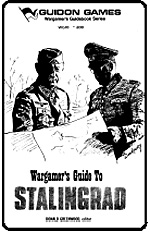 Wargamer’s Guidebook Series WG10-200
Wargamer’s Guidebook Series WG10-200
Edited by Donald Greenwood
Illustrated by Donald S. Lowry
Published by Guidon Games, USA, 1972
Physically, this is an illustrated, 66-page, folio-sized, offset-print, black and white booklet with a heavy white cardstock cover printed in black and red ink and bound with two staples.
Chronologically, this was the third title in the Wargamer’s Guidebook Series, after the Wargamer’s Guide to Afrika Korps and the Wargamer’s Guide to Battle of the Bulge. (It is unclear whether the fourth title, the Wargamer’s Guide to Blitzkrieg, was ever published.) However this title was also the second edition, as it was the first such work to be published and was originally printed by spirit master as were the contemporary Panzerfaust magazines.
 The table of contents included 11 articles,
10 of which had previously appeared in other magazines.
The table of contents included 11 articles,
10 of which had previously appeared in other magazines.
To understand the initial popularity of Stalingrad, you must put yourself back to 1963, the year that JFK was assassinated. It was only 11 years since Charles Swann Roberts II had published Tactics. Avalon Hill’s The General was the closest thing to a national wargaming magazine. SPI was still six years away. The mainstream wargames available at the time were: Tactics (1952); Dispatcher; Gettysburg; Tactics II; and U-Boat (1958); Verdict (1959); C&O/B&O; In the Year of Our Lord; Conflict; Battle of Atlanta; and Trade Winds (1960); Air Empire; Chancellorsville; Civil War; D-Day; Nieuchess; Waterloo; Diplomacy; 1863; Battle Cry; Civil War; and Skirmish (1961); Bismarck; and Broadsides (1962); Dogfight; Hit the Beach; and Battle of the Little Big Horn (1963).
That’s a total of 27 wargames, 28 if you count Stalingrad. Now are you beginning to get the picture? And yet, at the time, Stalingrad had one of the worst cross-the-counter sales records of any of Avalon Hill’s games. The only thing that saved it from cancellation was the excellent mail order sales from what Avalon Hill referred to as its “hard corps” devotees.
Originally, the game was to be called Barbarossa, which would have been more descriptive of its scope. But it was felt at the time that there was little popular recognition of that name, and Stalingrad was chosen instead.
This little booklet is a fascinating trip back to the beginnings of board war gaming, when new wargames were published at an agonizingly slow rate by a precious few publishers. That was long ago, and many of us may have forgotten that this was how it all began. It is best not to become complacent.
Back to Simulacrum Vol. 4 No. 1 Table of Contents
Back to Simulacrum List of Issues
Back to MagWeb Master Magazine List
© Copyright 2001 by Steambubble Graphics
This article appears in MagWeb (Magazine Web) on the Internet World Wide Web. Other articles from military history and related magazines are available at http://www.magweb.com